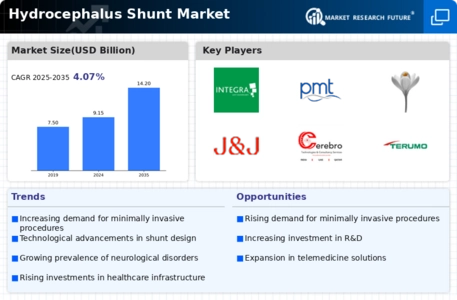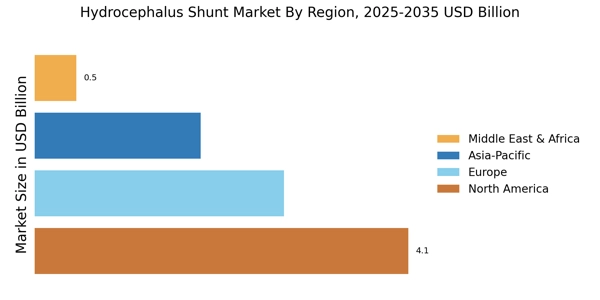Growing Geriatric Population
The Hydrocephalus Shunt Market is also being driven by the growing geriatric population, which is more susceptible to conditions that may lead to hydrocephalus, such as normal pressure hydrocephalus. As the global population ages, the incidence of neurological disorders is anticipated to rise, leading to an increased demand for effective treatment options. The elderly often require surgical interventions, including the placement of shunts, to manage their conditions. This demographic shift is likely to create a sustained demand for hydrocephalus shunt devices, as healthcare systems adapt to the needs of an aging population. Consequently, the Hydrocephalus Shunt Market is expected to see a significant uptick in product demand and innovation.
Increased Healthcare Expenditure
Increased healthcare expenditure across various regions is contributing to the growth of the Hydrocephalus Shunt Market. As governments and private sectors invest more in healthcare infrastructure, there is a corresponding rise in the availability of advanced medical devices, including shunt systems. This financial commitment enables hospitals and clinics to procure the latest technologies, improving patient care and outcomes. Furthermore, higher healthcare spending often correlates with increased awareness and diagnosis of conditions like hydrocephalus, leading to more patients seeking treatment. The Hydrocephalus Shunt Market stands to benefit from this trend, as enhanced funding allows for better access to shunt devices and related services.
Rising Incidence of Hydrocephalus
The Hydrocephalus Shunt Market is experiencing growth due to the rising incidence of hydrocephalus, a condition characterized by an accumulation of cerebrospinal fluid in the brain. Recent estimates suggest that hydrocephalus affects approximately 1 in every 1,000 births, with a notable prevalence in both pediatric and adult populations. This increasing incidence necessitates the development and deployment of effective shunt systems to manage the condition. As awareness of hydrocephalus grows, healthcare providers are more likely to diagnose and treat the condition, thereby driving demand for shunt devices. The Hydrocephalus Shunt Market is thus positioned to expand as more patients seek treatment options, leading to a greater need for innovative shunt technologies.
Rising Research and Development Activities
The Hydrocephalus Shunt Market is witnessing a surge in research and development activities aimed at improving shunt technologies. Academic institutions and private companies are increasingly focusing on developing innovative solutions to address the challenges associated with hydrocephalus management. This includes exploring new materials, designs, and delivery methods for shunt systems. The emphasis on R&D is likely to lead to breakthroughs that enhance the performance and safety of shunts, thereby attracting more healthcare providers to adopt these technologies. As a result, the Hydrocephalus Shunt Market is expected to experience growth driven by the continuous evolution of shunt devices, ultimately improving patient outcomes.
Technological Innovations in Shunt Systems
Technological advancements in shunt design are significantly influencing the Hydrocephalus Shunt Market. Innovations such as programmable valves and biocompatible materials are enhancing the efficacy and safety of shunt systems. These advancements not only improve patient outcomes but also reduce the risk of complications associated with traditional shunt devices. The introduction of smart shunt systems, which can be monitored remotely, is also gaining traction. As these technologies evolve, they are likely to attract investment and research, further propelling the Hydrocephalus Shunt Market. The integration of advanced materials and designs is expected to lead to a more efficient management of hydrocephalus, thereby increasing the adoption of shunt systems.


















Leave a Comment